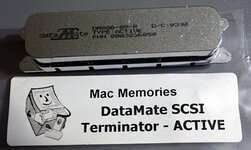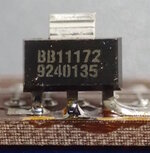Maybe it just adds the 2.2uF and 0.01uF caps just like what you pointed out in your other post?
Ding! Ding! Ding! Give this man a prize.
I just broke out my LCR meter and took another shot at measuring the 'filter' portion of the parts. Previously, I had been testing signal pins between terminator power and ground -- assuming a change in inductance, capacitance, or resistance would show up there. This time, I just sort of randomly tested pins.
Between pin 26 (terminator power) and pin 24 (n/c) there is an embedded 2.2 uF capacitor. And between pin 26 (terminator power) and pin 28 (n/c) there is an embedded 0.01 uF capacitor. It is weird that they chose the no-connect pins rather than between terminator power and ground. But, it explains why they wired ground to the n/c pins on the 'terminator' portion of the parts -- to connect the capacitors.
These capacitor values are the same values as Apple uses on their IIfx black terminator and newer gray passive terminator.
Based on figures 11-5, 11-7, 11-8, and 11-9 from Apple's hardware guide, plugging the 'filter' onto an otherwise empty internal SCSI port on the:
Macintosh II and SE: Will connect the capacitors to ground and enable them.
Macintosh SE/30, IIx, IIcx, IIci, IIfx: Will not connect the capacitors to ground
Adding an internal drive or internal terminator which contains traces connecting ground to pins 24 and 28 will also enable the capacitors. This is the most common case.
Apple's recommendation to plug the filter nearest to the internal drive is appropriate. You want the capacitors nearest to the switching signals to reduce noise. Farther away will provide some benefit, just not as good.
I assume newer drives, terminators, and Macs include adequate capacitors, thus diminishing returns for the added capacitors of the filter.




